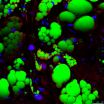(Press-News.org) Hamilton, ON (Dec. 8, 2014) - Researchers from McMaster University have identified an important hormone that is elevated in obese people and contributes to obesity and diabetes by inhibiting brown fat activity.
Brown adipose tissue, widely known as brown fat, is located around the collarbone and acts as the body's furnace to burn calories. It also keeps the body warm. Obese people have less of it, and its activity is decreased with age. Until now, researchers haven't understood why.
There are two types of serotonin. Most people are familiar with the first type in the brain or central nervous system which affects mood and appetite. But this makes up only five per cent of the body's serotonin.
The lesser-known peripheral serotonin circulates in the blood and makes up the other 95 per cent of the body's serotonin. McMaster researchers have discovered that this kind of serotonin reduces brown fat activity or "dials down" the body's metabolic furnace.
The study, published today in Nature Medicine, is the first to show that blocking the production of peripheral serotonin makes the brown fat more active.
"Our results are quite striking and indicate that inhibiting the production of this hormone may be very effective for reversing obesity and related metabolic diseases including diabetes," said Gregory Steinberg, the paper's co-author and professor of medicine at the Michael G. DeGroote School of Medicine. He is also co-director of MAC-Obesity, the Metabolism and Childhood Obesity Research Program at McMaster.
"Too much of this serotonin acts like the parking brake on your brown fat," he explained. "You can step on the gas of the brown fat, but it doesn't go anywhere."
The culprit responsible for elevated levels of peripheral serotonin may also have been found.
"There is an environmental cue that could be causing higher serotonin levels in our body and that is the high-fat western diet," said Waliul Khan, co- author, associate professor of pathology and molecular medicine for the medical school and a principal investigator at Farncombe Family Digestive Research Institute. "Too much serotonin is not good. We need a balance. If there is too much, it leads to diabetes, fatty liver and obesity."
The majority of serotonin in the body is produced by tryptophan hydroxylase (Tph1). The McMaster team found that when they genetically removed or inhibited this enzyme that makes serotonin that mice fed a high-fat diet were protected from obesity, fatty liver disease and pre-diabetes due to an enhanced ability of the brown fat to burn more calories.
Notably, inhibiting the peripheral serotonin doesn't affect the serotonin in the brain or central nervous system functioning, said Steinberg.
This is in contrast to earlier weight loss drugs which worked to suppress appetite by affecting levels of brain serotonin, but were associated with problems including cardiac complications and increased risk of depression and suicide.
"Moving forward, we think it's a much safer method to work with increasing energy expenditure instead of decreasing the appetite, which involves more risks," said Steinberg.
The researchers conclude that reducing the production of serotonin by inhibition of Tph1 "may be an effective treatment for obesity and its comorbidities," and so the team is now working on a pharmacological "enzyme blocker."
INFORMATION:
This study, conducted over five years, was supported by funding from the Canadian Diabetes Association, the Canadian Institutes of Health Research, Crohn's and Colitis Canada, MAC-Obesity and the Natural Sciences and Engineering Research Council of Canada.
Editors:
A picture of the authors may be found here: http://bit.ly/1FKkNtu
For more information:
Veronica McGuire
Media relations
Faculty of Health Sciences
McMaster University
vmcguir@mcmaster.ca
905-525-9140, ext. 22169
Recently, the researchers had constructed several single molecules with dual hormone action. Now, for the first time, the researchers succeeded in designing a substance that combines three metabolically active hormone components (GLP-1, GIP and glucagon) and offers unmatched potency to fight metabolic diseases in pre-clinical trials.
The team headed by physician scientist Matthias Tschöp (Helmholtz Diabetes Center at HMGU and Metabolic Diseases Chair at TUM) and peptide chemist Richard DiMarchi (Indiana University) has been cooperating for almost a decade to invent ...
Harvard Stem Cell Institute researchers at Harvard and Massachusetts General Hospital have taken what they are describing as "the first step toward a pill that can replace the treadmill" for the control of obesity - though it of course would not provide all the additional benefits of exercise.
Chad Cowan, an HSCI Principal Faculty Member and his HSCI team report that they have created a system using human stem cells to screen for compounds that have the potential to turn white, or 'bad', fat cells into brown, or 'good' fat cells, and have already identified two compounds ...
Titan, Saturn's largest moon, is a peculiar place. Unlike any other moon, it has a dense atmosphere. It has rivers and lakes made up of components of natural gas, such as ethane and methane. It also has windswept dunes that are hundreds of yards high, more than a mile wide and hundreds of miles long--despite data suggesting the body to have only light breezes.
Research led by Devon Burr, an associate professor in the Earth and Planetary Sciences Department at the University of Tennessee, Knoxville, shows that winds on Titan must blow faster than previously thought to ...
New nanopore DNA sequencing technology on a device the size of a USB stick could be used to diagnose infection - according to new research from the University of East Anglia and Public Health England.
Researchers tested the new technology with a complex problem - determining the cause of antibiotic resistance in a new multi-drug resistant strain of the bacterium that causes Typhoid.
The results, published today in the journal Nature Biotechnology, reveal that the small, accessible and cost effective technology could revolutionise genomic sequencing.
Current technology ...
For a small percentage of cancer patients, treatment aimed at curing the disease leads to a form of leukemia with a poor prognosis. Conventional thinking goes that chemotherapy and radiation therapy induce a barrage of damaging genetic mutations that kill cancer cells yet inadvertently spur the development of acute myeloid leukemia (AML), a blood cancer.
But a new study at Washington University School of Medicine in St. Louis challenges the view that cancer treatment in itself is a direct cause of what is known as therapy-related AML.
Rather, the research suggests, ...
BOSTON and CAMBRIDGE -- The genetic tumult within cancerous tumors is more than matched by the disorder in one of the mechanisms for switching cells' genes on and off, scientists at Dana-Farber Cancer Institute and the Broad Institute of MIT and Harvard report in a new study. Their findings, published online today in the journal Cancer Cell, indicate that the disarray in the on-off mechanism - known as methylation - is one of the defining characteristics of cancer and helps tumors adapt to changing circumstances.
The researchers also showed that derangement in ...
BOSTON -- Small cell lung cancer - a disease for which no new drugs have been approved for many years - has shown itself vulnerable to an agent that disables part of tumor cells' basic survival machinery, researchers at Dana-Farber Cancer Institute and the Massachusetts Institute of Technology reported.
In a study published today in the journal Cancer Cell, the investigators found that the agent THZ1 caused human-like small cell lung tumors in mice to shrink significantly, with no apparent side effects. The compound is now being developed into a drug for testing ...
COLUMBUS, OH - As interest in organic agricultural and horticultural practices continues to grow, so does the need to identify alternative weed control practices. Mulching, a common practice used to control weeds and reduce the need for tillage, can also reduce insect pollinators' exposure to harmful pesticides; however, finding the right mulch materials that allow pollinators to flourish can be challenging. Caitlin E. Splawski, from The Ohio State University Department of Horticulture and Crop Science, researched the effects of several types of organic mulch on squash ...
WASHINGTON, Dec. 8, 2014 -- There's probably a box of it in your fridge or cupboard, and it has a million uses: baking soda. Reactions is back with volume four of its popular Chemistry Life Hacks series, with tips on how to de-skunk your dog, clean your kitchen and supercharge your washing machine. Check out the latest in the series that's one-part MacGyver, one-part Mendeleev here: http://youtu.be/85diRmuk-ow.
Subscribe to the series at Reactions YouTube, and follow us on Twitter @ACSreactions to be the first to see our latest videos.
The American Chemical Society ...
Nearly half of all children in the United States are exposed to at least one social or family experience that can lead to traumatic stress and impact their healthy development - be it having their parents divorce, a parent die or living with someone who abuses alcohol or drugs - increasing the risk of negative long-term health consequences or of falling behind in school, suggests new research led by the Johns Hopkins Bloomberg School of Public Health.
The study reports on new data showing the magnitude of these adverse experiences in the child population in the U.S., ...





